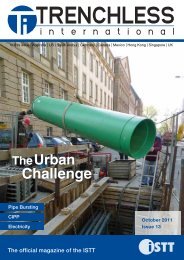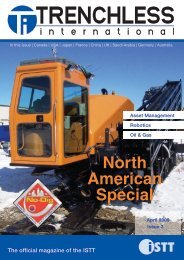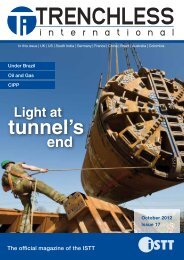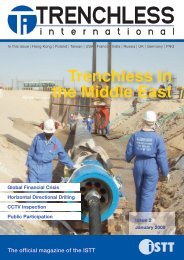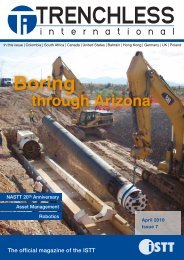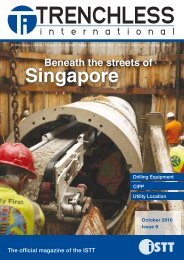on the Black Sea - Trenchless International
on the Black Sea - Trenchless International
on the Black Sea - Trenchless International
Create successful ePaper yourself
Turn your PDF publications into a flip-book with our unique Google optimized e-Paper software.
MANhOLes<br />
July 2010 - <strong>Trenchless</strong> Internati<strong>on</strong>al<br />
52<br />
how to select access<br />
chamber coatings<br />
by Ian Bateman, Interflow<br />
Manhole maintenance is essential to <strong>the</strong> upkeep of <strong>the</strong> entire wastewater system. Ian Bateman from<br />
Australasian relining company Interflow looks at <strong>the</strong> role of calcium aluminate cements in <strong>the</strong> strategy<br />
for renewing access chamber and underground structures.<br />
The TreNchLeSS SeWer rehabilitati<strong>on</strong><br />
industry is well established in Australia<br />
and New Zealand and has grown from<br />
its origins in pipeline rehabilitati<strong>on</strong> to now<br />
include additi<strong>on</strong>al parts of <strong>the</strong> network<br />
such as house service lines, lateral c<strong>on</strong>necti<strong>on</strong><br />
juncti<strong>on</strong>s, and access chambers.<br />
In recent years <strong>the</strong> importance of renewing<br />
and sealing <strong>the</strong> entire sewer network to<br />
prevent leaks, infiltrati<strong>on</strong> and collapses has<br />
been widely recognised by many sewer<br />
asset owners. One aspect that is becoming<br />
increasingly important is renewal of access<br />
chambers (also referred to as manholes,<br />
maintenance holes, or utility holes).<br />
Access chambers represent a significant<br />
proporti<strong>on</strong> of <strong>the</strong> total surface area of a<br />
sewer network. <strong>the</strong> table below puts this<br />
into perspective.<br />
A program that leaves <strong>the</strong> access chamber<br />
untreated, leaves up to 30 per cent<br />
of <strong>the</strong> network untreated. Additi<strong>on</strong>ally, if<br />
<strong>the</strong> main pipeline is relined, <strong>the</strong> level of<br />
hydrogen sulphide present in <strong>the</strong> sewer<br />
atmosphere will typically increase because<br />
<strong>the</strong> gas sink present in <strong>the</strong> host pipe walls<br />
has been removed. this may result in<br />
an accelerated rate of gas attack at <strong>the</strong><br />
access chambers.<br />
Given that it is accepted that access<br />
chambers do require a rehabilitati<strong>on</strong> strategy<br />
<strong>the</strong> questi<strong>on</strong>s <strong>the</strong>n become:<br />
1. When do <strong>the</strong>y need to be rehabilitated?<br />
2. How do we determine <strong>the</strong> c<strong>on</strong>diti<strong>on</strong> of<br />
<strong>the</strong> asset?<br />
3. What are <strong>the</strong> most appropriate<br />
products to use?<br />
<strong>the</strong>se are essentially <strong>the</strong> same questi<strong>on</strong>s<br />
that apply to <strong>the</strong> pipelines but <strong>the</strong><br />
dynamics with access chambers are quite<br />
different.<br />
When do access chambers need to<br />
be rehabilitated?<br />
When answering this questi<strong>on</strong> as it<br />
applies to pipelines, asset owners will typically<br />
take an approach that c<strong>on</strong>siders <strong>the</strong><br />
c<strong>on</strong>diti<strong>on</strong> of <strong>the</strong> asset and <strong>the</strong> criticality<br />
of asset (i.e. <strong>the</strong> c<strong>on</strong>sequence of failure).<br />
Based <strong>on</strong> ranking each asset according to<br />
its criticality and c<strong>on</strong>diti<strong>on</strong>, a priority matrix<br />
can be created that identifies which pipelines<br />
should be d<strong>on</strong>e and when.<br />
<strong>the</strong> same approach seems reas<strong>on</strong>able<br />
for access chambers but <strong>the</strong>re are significant<br />
differences in two areas:<br />
a. <strong>the</strong> cost dynamics<br />
b. <strong>the</strong> method of c<strong>on</strong>diti<strong>on</strong> assessment.<br />
It is important to understand <strong>the</strong> difference<br />
in cost dynamics that apply to<br />
pipeline rehabilitati<strong>on</strong> versus access<br />
chamber rehabilitati<strong>on</strong>. When a pipe is<br />
renewed a liner is placed inside <strong>the</strong> host<br />
pipe and it is typically assumed that <strong>the</strong><br />
existing pipe is fully deteriorated. In o<strong>the</strong>r<br />
words, no attempt is made to determine <strong>the</strong><br />
c<strong>on</strong>diti<strong>on</strong> of <strong>the</strong> existing pipe and to offer a<br />
soluti<strong>on</strong> that replaces its lost strength. It is<br />
simply too difficult to assess <strong>the</strong> remaining<br />
strength of pipe so <strong>the</strong> industry takes a<br />
c<strong>on</strong>servative approach and assumes its<br />
strength is zero. As a c<strong>on</strong>sequence, from<br />
an asset management point of view, <strong>the</strong>re<br />
is no sliding scale of renewal costs as <strong>the</strong><br />
asset deteriorates. Whe<strong>the</strong>r <strong>the</strong> asset has<br />
lost all of its strength or <strong>on</strong>ly five per cent<br />
of its strength <strong>the</strong> relining cost will be <strong>the</strong><br />
same. <strong>the</strong>refore <strong>the</strong> optimum renewal time<br />
for <strong>the</strong> pipe (from a lifecycle cost point of<br />
view) will be just before it fails.<br />
this is not <strong>the</strong> case with access chamber<br />
rehabilitati<strong>on</strong>. <strong>the</strong>re are several<br />
types of products that can be applied to<br />
access chambers each with very different<br />
cost dynamics:<br />
Protective coating<br />
A protective coating can be applied to<br />
a structure that has not underg<strong>on</strong>e significant<br />
structural loss. For all intents <strong>the</strong><br />
structure remaining is fully intact. Under<br />
this scenario a thin protective layer can<br />
be applied. <strong>the</strong> coating would not need to<br />
offer any structural characteristic. It would<br />
be capable of withstanding <strong>the</strong> gas attack<br />
and <strong>the</strong>refore extending <strong>the</strong> asset life.<br />
this would be c<strong>on</strong>sidered to be taking a<br />
preventative maintenance approach. <strong>the</strong><br />
costs for this type of coating would be<br />
distance between access chambers – 50 m<br />
diameter of chamber – 1,050 mm<br />
Pipe diameter Percentage of total network surface area<br />
residing in <strong>the</strong> access chambers<br />
150 mm 30 per cent<br />
225 mm 22 per cent<br />
300 mm 17 per cent<br />
c<strong>on</strong>diti<strong>on</strong><br />
of access<br />
chamber<br />
Minimal structural<br />
loss (e.g.<br />
less than 20<br />
mm) at a loss<br />
rate of less<br />
than 5 mm per<br />
year<br />
Minimal structural<br />
loss (e.g.<br />
less than 20<br />
mm) at a loss<br />
rate greater<br />
than 5 mm per<br />
year<br />
some structural<br />
loss<br />
that requires<br />
reinstatement.<br />
Rate loss of<br />
c<strong>on</strong>crete less<br />
than 5 mm per<br />
year<br />
some structural<br />
loss<br />
that requires<br />
reinstatement.<br />
Rate loss<br />
of c<strong>on</strong>crete<br />
greater than<br />
5 mm per<br />
year<br />
Complete<br />
structural loss<br />
Type of product<br />
needed<br />
relatively low compared to <strong>the</strong> o<strong>the</strong>r types<br />
of coatings. <strong>the</strong> types of products would<br />
include thin polymeric coatings such as<br />
polyurea, polyurethane and epoxy and<br />
cementitious products such as calcium<br />
aluminate cement.<br />
Rebuild coatings<br />
A rebuild coating would be needed<br />
where <strong>the</strong> structural integrity of <strong>the</strong><br />
existing access chamber has been compromised.<br />
In this case it is appropriate to<br />
reinstate <strong>the</strong> lost structure with a material<br />
that has some structural strength and<br />
it would need to be applied in a thickness<br />
commensurate with <strong>the</strong> degree of<br />
Thin, n<strong>on</strong>structural<br />
polymeric<br />
coating<br />
Polyurea,<br />
polyurethane,<br />
high purity<br />
epoxy<br />
Thick,<br />
structural<br />
polymeric<br />
coating calcium<br />
epoxy mortar,<br />
highly filled<br />
epoxies<br />
aluminate<br />
cement<br />
Protective<br />
Coating suitable suitable suitable<br />
Protective<br />
Coating suitable suitable<br />
Rebuild<br />
Coating<br />
Unsuitable<br />
Would need to<br />
be top coated<br />
with a polymeric<br />
product<br />
Unsuitable suitable suitable<br />
Rebuild<br />
Coating Unsuitable suitable<br />
Unsuitable<br />
Would need to<br />
be top coated<br />
with a polymeric<br />
product<br />
Rec<strong>on</strong>struct Unsuitable Unsuitable Unsuitable<br />
deteriorati<strong>on</strong>. typically costs for this type<br />
of treatment would be up to double that<br />
of <strong>the</strong> protective coating and gradually<br />
increase as <strong>the</strong> thickness of product<br />
increases (i.e. <strong>the</strong> amount required to<br />
restore <strong>the</strong> structural strength).<br />
Rec<strong>on</strong>struct<br />
A rec<strong>on</strong>struct is needed when <strong>the</strong> existing<br />
access chamber has lost nearly all<br />
of its structure. In this case some form<br />
of rec<strong>on</strong>structi<strong>on</strong> technique is needed.<br />
this can include reboring a new access<br />
chamber, slip lining <strong>the</strong> existing chamber<br />
or internally rec<strong>on</strong>structing. Naturally this<br />
situati<strong>on</strong> is very expensive and would<br />
expect to cost at least four times more<br />
than <strong>the</strong> protective coating.<br />
From <strong>the</strong> foregoing discussi<strong>on</strong> it can<br />
be appreciated that <strong>the</strong> optimum time<br />
to renew an access chamber from an<br />
ec<strong>on</strong>omic point of view is not necessarily<br />
obvious. <strong>the</strong> graphs above express<br />
<strong>the</strong> difference in cost dynamics between<br />
access chambers and pipelines. <strong>the</strong> optimum<br />
ec<strong>on</strong>omic time for a pipeline is<br />
towards <strong>the</strong> end of its life. For an access<br />
chamber it could be at points 1, 2 or 3.<br />
how do we determine <strong>the</strong><br />
c<strong>on</strong>diti<strong>on</strong> of an access chamber?<br />
Determining <strong>the</strong> c<strong>on</strong>diti<strong>on</strong> of a pipeline<br />
is a relatively difficult task that has developed<br />
significantly and is now able to be<br />
performed in a c<strong>on</strong>sistent way by skilled<br />
operators that follow techniques and<br />
guidelines set out by industry standards.<br />
<strong>the</strong> tool of choice in all cases is CCtV<br />
footage that is subsequently interpreted<br />
by a skilled operator.<br />
An access chamber has <strong>on</strong>e significant<br />
benefit over a pipeline in that it is<br />
accessible. As such we are not limited to<br />
assessing <strong>the</strong> c<strong>on</strong>diti<strong>on</strong> by using images.<br />
We can actually take core samples directly<br />
from <strong>the</strong> access chamber. this is particularly<br />
helpful in circumstances where<br />
<strong>the</strong> access chamber was cast in-situ,<br />
because it tells us exactly how thick <strong>the</strong><br />
structure is, not just how much c<strong>on</strong>crete<br />
has been lost.<br />
<strong>the</strong>re are significant benefits in taking<br />
core samples from manholes. If we were<br />
to <strong>on</strong>ly look at <strong>the</strong> images, <strong>the</strong> c<strong>on</strong>diti<strong>on</strong> of<br />
each appears equivalent, i.e. <strong>on</strong>e would<br />
probably c<strong>on</strong>clude that <strong>the</strong> chamber is<br />
structurally sound and requires <strong>on</strong>ly a<br />
protective coating. However after taking<br />
a core sample, a very different c<strong>on</strong>clusi<strong>on</strong><br />
was drawn.<br />
Given <strong>the</strong> costs of each soluti<strong>on</strong> are<br />
potentially very different, and that <strong>the</strong> risk<br />
profile of each is very different, <strong>the</strong> c<strong>on</strong>sequences<br />
of using <strong>on</strong>ly a visual assessment<br />
to determine <strong>the</strong> c<strong>on</strong>diti<strong>on</strong> of <strong>the</strong> access<br />
chamber can be quite serious.<br />
MANhOLes<br />
July 2010 - <strong>Trenchless</strong> Internati<strong>on</strong>al 53






